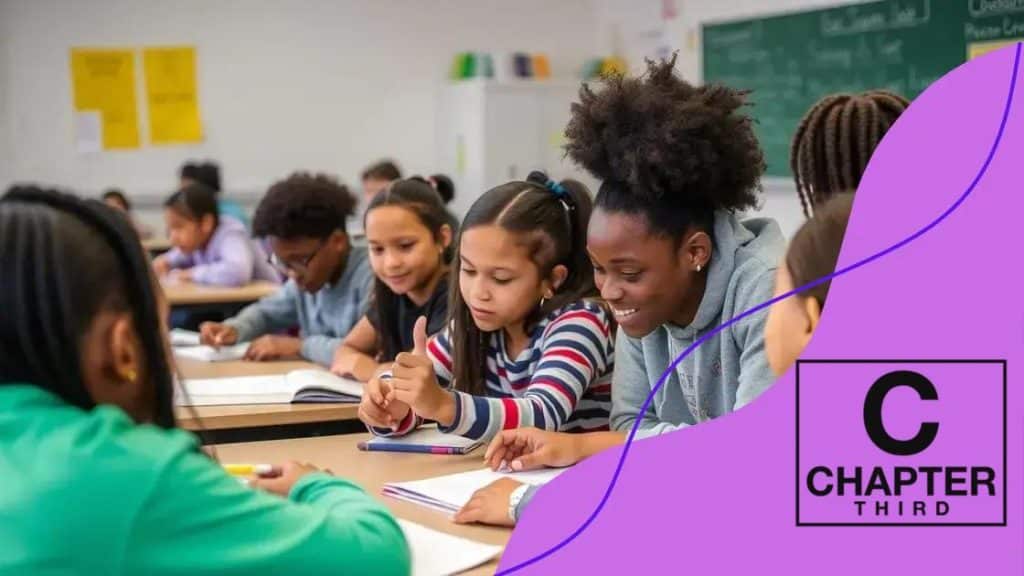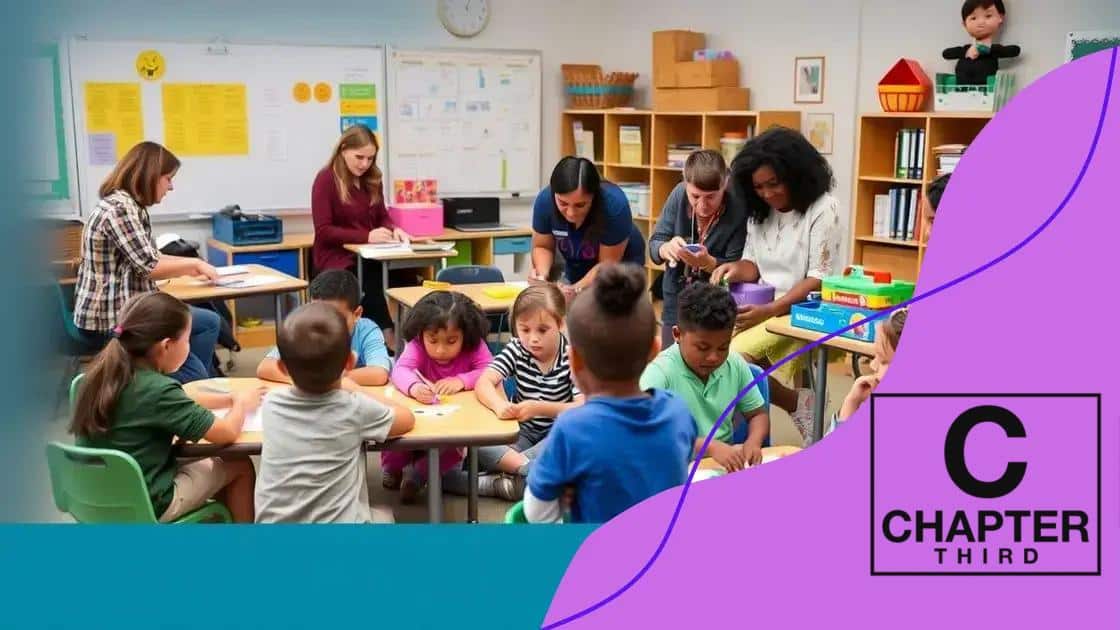Neurodiversity programs grow in education: a closer look

Neurodiversity programs grow in education by creating inclusive environments tailored to diverse learning needs, enhancing student engagement, and fostering collaboration among educators, families, and specialists for better academic and social outcomes.
Neurodiversity programs grow in education, transforming how schools approach different learning needs. Have you seen how these initiatives impact students and classrooms? Let’s explore this exciting shift together.
Understanding neurodiversity in education
Understanding neurodiversity in education is fascinating and essential. It’s about recognizing the different ways our brains work and how this diversity can enrich learning environments. Everyone has a unique way of processing information, and celebrating that uniqueness can lead to better educational outcomes.
What is Neurodiversity?
Neurodiversity refers to the variety of human brain functioning and the idea that neurological differences should be recognized and respected as any other human variation. Conditions such as autism, ADHD, dyslexia, and others fall under this umbrella. Each condition has its own set of characteristics, strengths, and challenges.
Importance of Understanding Neurodiversity
Recognizing and understanding neurodiversity in educational settings is crucial. It helps educators create more inclusive classrooms. When teachers understand how neurodiverse students learn, they can tailor their teaching strategies to fit different needs.
- Everyone learns differently.
- Different methods can enhance learning experiences.
- Respecting these differences fosters a positive classroom environment.
Inclusive strategies can include differentiated instruction, sensory-friendly spaces, and varied assessment methods. These approaches ensure that all students, including those who are neurodiverse, can thrive in their learning journeys. Moreover, schools that implement neurodiversity programs not only support these students but also teach empathy and understanding to their peers. This creates a supportive community where all students feel valued.
As educational institutions embrace neurodiversity, they recognize the benefits of diverse perspectives. By utilizing a range of teaching methods, schools can help every student reach their potential. It’s not just about accommodating differences; it’s about celebrating them as strengths that can enrich everyone’s learning experience. Understanding neurodiversity ultimately transforms the educational landscape, creating vibrant and engaging learning communities.
Benefits of neurodiversity programs
The benefits of neurodiversity programs in education are impressive and multi-faceted. These programs play a significant role in supporting diverse learners, helping them to excel in their educational journeys. One of the primary advantages is the creation of inclusive learning environments where every student feels valued and recognized for their unique contributions.
Enhancing Student Engagement
Neurodiversity programs enhance student engagement by utilizing varied teaching methods that cater to different learning styles. Engaging lessons that respect each child’s way of learning can lead to improved participation and enthusiasm for learning.
- Hands-on activities help kinesthetic learners.
- Visual aids support those who learn better through images.
- Group work encourages social interaction and teamwork.
Furthermore, these programs foster empathy among students. When children learn about neurodiversity, they develop a greater understanding of their peers’ experiences. This, in turn, reduces stigma and promotes a culture of acceptance. Educators can facilitate discussions about differences, helping students appreciate diversity.
Academic Success and Skill Development
Another crucial benefit is the academic success linked to neurodiversity programs. Tailoring instruction to meet diverse needs can lead to higher achievement levels. Students receive support that reflects their strengths, allowing them to thrive in their studies. This personalized attention makes learning more effective and enjoyable.
Moreover, students in neurodiversity-focused classrooms often develop essential life skills alongside academics. They learn important traits like resilience and adaptability, preparing them for future challenges. These programs provide the tools necessary for students to navigate social situations and collaborate with others successfully.
Education systems that invest in neurodiversity programs contribute to societal change. By promoting awareness and understanding, schools foster a generation of empathetic individuals equipped to work in diverse environments. It’s clear that the benefits of these programs extend beyond the classroom, impacting students’ lives in profound ways.
Implementing inclusive practices at schools

Implementing inclusive practices at schools is vital for fostering an environment where all students can succeed. These practices ensure that every child’s unique learning needs are recognized and addressed, leading to a more equitable educational experience. By prioritizing inclusivity, schools can promote a sense of belonging and acceptance for every student.
Key Strategies for Inclusion
There are various strategies that schools can adopt to implement inclusive practices effectively. One essential strategy is the use of differentiated instruction, which tailors teaching methods to accommodate various learning styles. This approach respects individual differences and helps all students reach their potential.
- Utilizing visual aids for visual learners.
- Incorporating hands-on activities for kinesthetic learners.
- Offering verbal explanations and discussions for auditory learners.
Another important aspect is creating sensory-friendly spaces within the classroom. These areas help students who may become overwhelmed, allowing them to regulate their emotions and focus better. Providing tools like noise-canceling headphones, calming visuals, or break areas can significantly enhance the learning experience for neurodiverse students.
Fostering Collaborative Learning
Collaboration among students is another vital component of inclusive practices. Group work not only builds teamwork skills but also encourages empathy as students learn from one another. By working together, students can share their various strengths and perspectives, enriching the educational experience for everyone.
Teachers can facilitate this by grouping students with different abilities and backgrounds, ensuring that everyone has a role in the learning process. This diversity fosters a culture of acceptance and understanding among peers. Moreover, involving parents and guardians in the implementation of these practices can create a stronger network of support, further enhancing the inclusive environment.
As schools implement these inclusive practices, they not only benefit neurodiverse students but also create a positive atmosphere for all learners. Emphasizing collaboration, safety, and awareness cultivates a rich educational environment where every student can thrive.
Real-world examples of success
Real-world examples of success in neurodiversity programs highlight the positive impact these initiatives can have on students. Schools around the world are implementing creative strategies to support diverse learners, resulting in inspiring outcomes that benefit everyone involved.
Case Study: Maple Grove High School
At Maple Grove High School, educators recognized a need for specialized approaches to support students with autism. They established a neurodiversity program that focuses on individualized learning plans. Teachers received training in understanding various learning styles, helping them tailor their lessons accordingly.
- Students participate in hands-on projects that cater to their interests.
- Regular feedback sessions ensure students feel heard and valued.
- A buddy system promotes social interaction and builds friendships.
As a result, student engagement increased significantly, with many students achieving higher grades and displaying improved social skills. The program became a model for other schools in the district.
Innovative Practices at Riverdale Academy
Another inspiring example comes from Riverdale Academy, which implemented a sensory-friendly learning environment. They included designated spaces where students can take breaks when feeling overwhelmed. These safe zones allow students to regroup and refocus. The adjustments have proven effective, leading to lower anxiety levels and better academic performance.
Students have reported feeling more supported, and their overall well-being improved. Teachers observed a decrease in disruptive behavior, allowing for a more productive classroom atmosphere. This initiative has inspired other institutions to consider similar adaptations, inviting positive changes across their curricula.
Both Maple Grove High School and Riverdale Academy exemplify how tailored neurodiversity programs can enhance educational experiences. By sharing these real-world successes, more schools can learn to implement inclusive practices. This encourages a greater understanding of the value that neurodiverse students bring to educational settings, helping build more inclusive communities.
The future of neurodiversity in educational settings
The future of neurodiversity in educational settings looks promising as awareness and understanding continue to grow. Schools are increasingly recognizing the importance of fostering inclusive environments where all students can thrive. As educators adapt their methods, they pave the way for innovations that benefit every learner.
Emerging Trends in Education
One significant trend is the integration of technology in learning. Assistive technologies like speech-to-text software and interactive learning tools enable neurodiverse students to engage more effectively. These tools help bridge gaps in learning, making education more accessible and tailored to individual needs.
- Virtual reality can create immersive learning experiences.
- Gamification encourages motivation and engagement.
- Online resources provide additional support outside the classroom.
Furthermore, teacher training programs are evolving to include comprehensive training on neurodiversity. Educators are learning how to identify and support diverse learning needs. This understanding leads to more effective teaching strategies that promote inclusion and respect for all students.
Collaboration Between Stakeholders
Collaboration among educators, parents, and specialists is crucial for creating supportive learning environments. Schools are increasingly fostering partnerships that involve families in the decision-making process. This engagement allows for a better understanding of students’ needs and encourages the implementation of personalized learning plans.
As collaboration deepens, we see a shift toward holistic approaches to education. Schools are focusing on the whole child, recognizing the importance of social-emotional learning alongside academic achievement. This approach helps build resilience and promotes mental health awareness within educational settings.
As discussions around neurodiversity continue, it’s clear that the future of education will be more inclusive. Policies are adapting, resources are expanding, and educators are committed to understanding and supporting all learners. With these changes, we can expect to see a generation of students who feel valued and empowered in their educational journeys.
In conclusion, the future of neurodiversity in educational settings is bright and full of potential. By embracing inclusive practices and leveraging technology, schools can create environments where every student thrives. Collaboration among educators, families, and specialists is essential for making meaningful changes. As awareness of neurodiversity grows, so does the commitment to supporting all learners. Together, we can build a more inclusive future for education, ensuring that every child has the opportunity to succeed.
FAQ – Frequently Asked Questions about Neurodiversity in Education
What are neurodiversity programs?
Neurodiversity programs are initiatives in education that recognize and support the unique learning needs of all students, particularly those with conditions like autism, ADHD, and dyslexia.
How do schools benefit from implementing inclusive practices?
Implementing inclusive practices helps create a supportive environment, enhances student engagement, and promotes social-emotional learning for all students.
What role does technology play in supporting neurodiverse students?
Technology, such as assistive tools and interactive learning platforms, helps neurodiverse students access information in ways that suit their learning styles, improving their educational experience.
Why is collaboration important in inclusive education?
Collaboration among educators, parents, and specialists ensures that student needs are met effectively, leading to personalized learning plans that promote success for neurodiverse learners.





